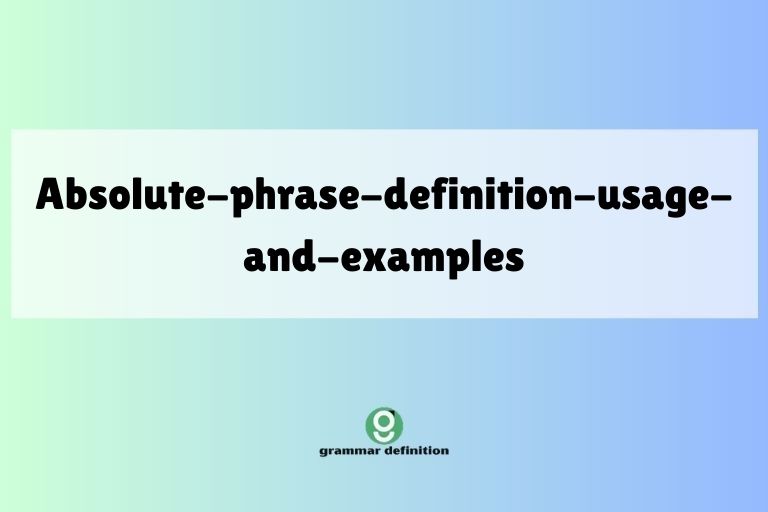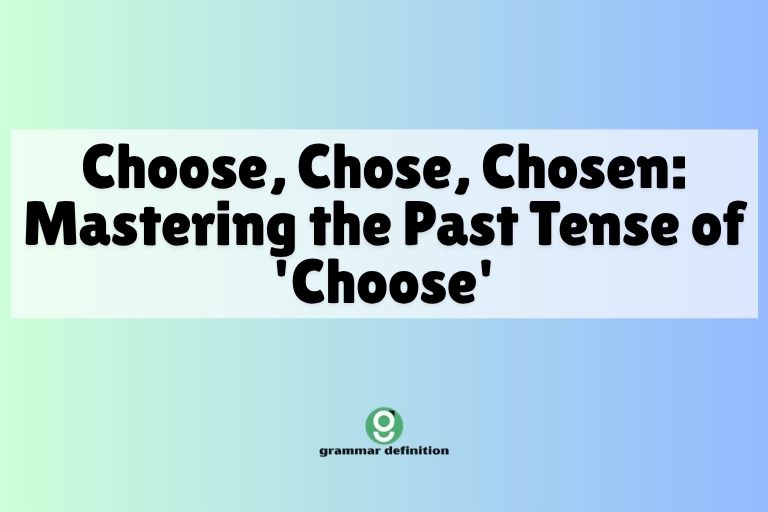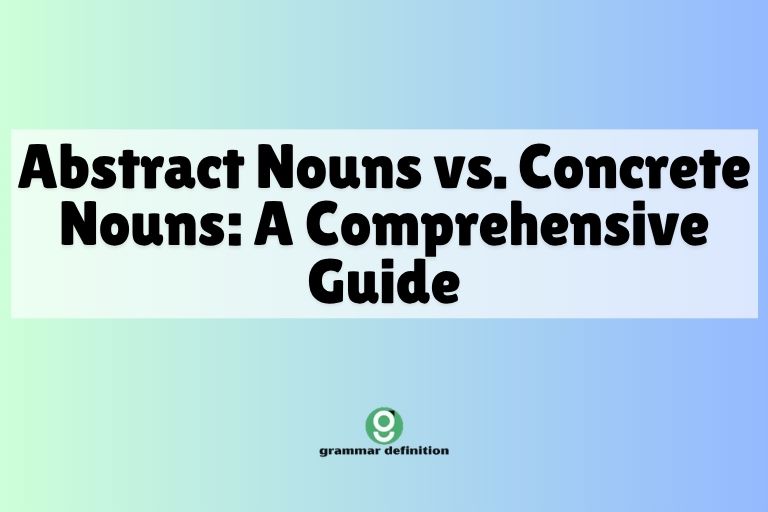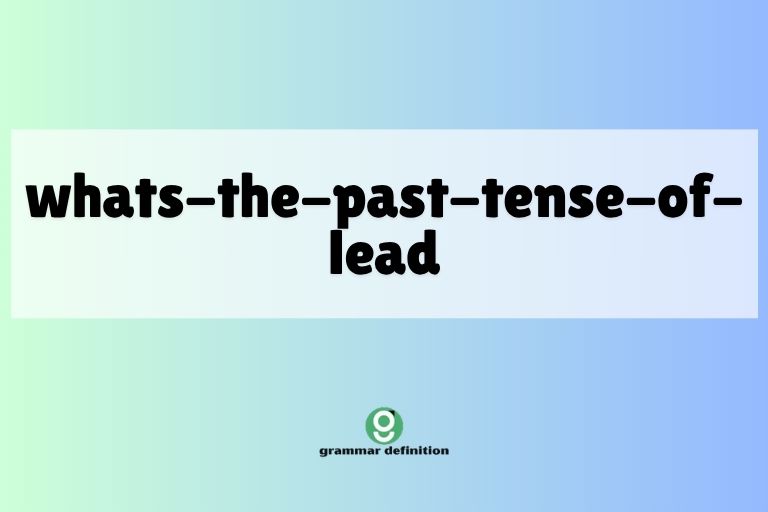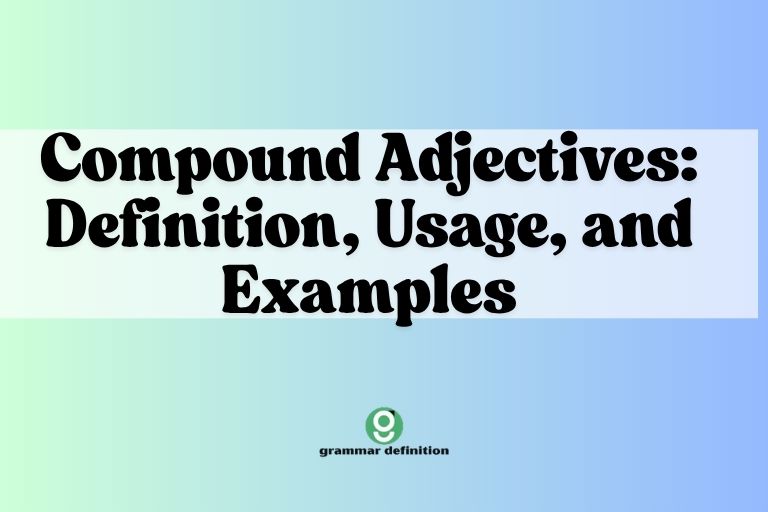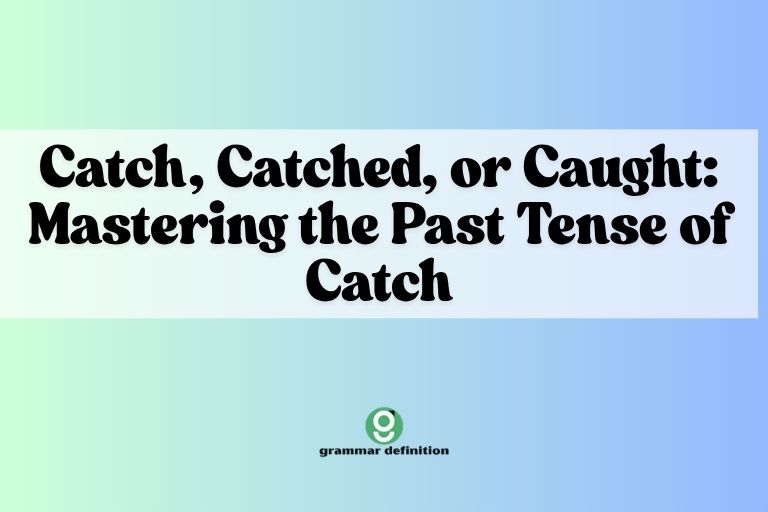Mastering the Present Continuous: Definition, Usage, and Examples
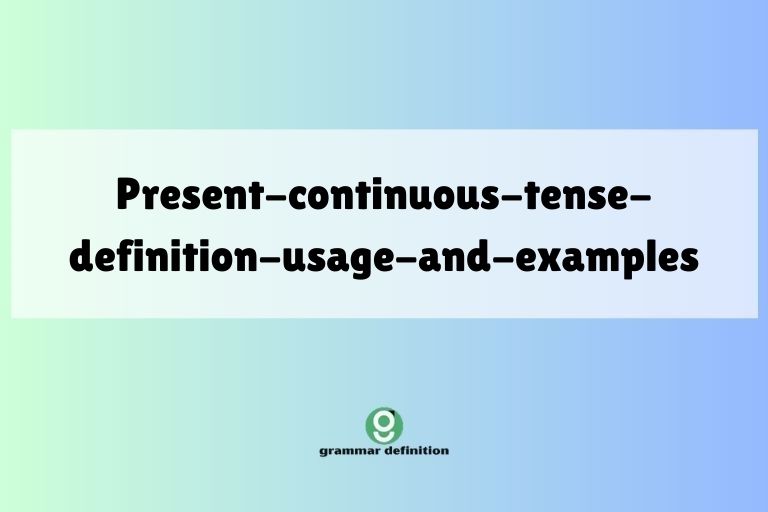
The present continuous tense, also known as the present progressive tense, is a fundamental aspect of English grammar. It allows us to describe actions happening right now, temporary situations, and even planned future events.
Understanding and using this tense correctly is essential for clear and effective communication. This article provides a comprehensive guide to the present continuous tense, covering its definition, structure, usage rules, common mistakes, and offering plenty of examples and practice exercises.
Whether you are a beginner or an advanced learner, this guide will help you master the present continuous tense and improve your English fluency.
Table of Contents
- Introduction
- Definition of the Present Continuous Tense
- Structural Breakdown
- Usage Rules of the Present Continuous Tense
- Examples of the Present Continuous Tense
- Stative Verbs and the Present Continuous
- Common Mistakes
- Practice Exercises
- Advanced Topics
- Frequently Asked Questions (FAQ)
- Conclusion
Introduction
The present continuous tense is a versatile and essential part of English grammar. It’s used to describe actions occurring at the moment of speaking, temporary states, pre-arranged future activities, and evolving situations.
Mastering this tense is crucial for expressing yourself accurately and naturally in English. Whether you’re a student learning English as a second language, a professional aiming to improve your communication skills, or simply someone interested in refining your grammar knowledge, this comprehensive guide provides the knowledge and practice you need to confidently use the present continuous tense.
Definition of the Present Continuous Tense
The present continuous tense, also known as the present progressive tense, is a verb tense used to describe actions or situations that are in progress at a specific time, usually around the present moment. It indicates that an action has started but is not yet finished.
It is formed using the auxiliary verb “to be” (am, is, are) and the present participle of the main verb (verb + -ing). This tense is dynamic, focusing on the ongoing nature of the action rather than its completion.
Understanding its function and context is key to using it correctly.The present continuous tense focuses on the duration and progression of an action, emphasizing that the action is currently underway.
Structural Breakdown
The present continuous tense is formed using the auxiliary verb “to be” (am, is, are) and the present participle of the main verb (verb + –ing). The form of “to be” depends on the subject of the sentence. Here’s a detailed breakdown of the structure in its affirmative, negative, and interrogative forms: Understanding the structure is crucial for forming grammatically correct sentences.
Affirmative Form
The affirmative form of the present continuous tense follows this pattern: Subject + am/is/are + verb-ing. The auxiliary verb “to be” must agree with the subject in number and person. For example, “I am,” “he/she/it is,” and “we/you/they are.” The main verb is always in its present participle form, which is created by adding “-ing” to the base form of the verb. Let’s explore some examples.
Here’s a table illustrating the affirmative form:
| Subject | Auxiliary Verb | Main Verb (Present Participle) | Example Sentence |
|---|---|---|---|
| I | am | reading | I am reading a book. |
| He | is | working | He is working on a project. |
| She | is | cooking | She is cooking dinner. |
| It | is | raining | It is raining outside. |
| We | are | watching | We are watching a movie. |
| You | are | listening | You are listening to music. |
| They | are | playing | They are playing football. |
Negative Form
The negative form of the present continuous tense is created by adding “not” after the auxiliary verb “to be.” The structure is: Subject + am/is/are + not + verb-ing. Contractions are commonly used in spoken and informal written English (e.g., “isn’t,” “aren’t”). Understanding how to negate the present continuous tense is important for expressing what isn’t happening.
Here’s a table illustrating the negative form:
| Subject | Auxiliary Verb + Not | Main Verb (Present Participle) | Example Sentence |
|---|---|---|---|
| I | am not | reading | I am not reading a book. |
| He | is not (isn’t) | working | He isn’t working on a project. |
| She | is not (isn’t) | cooking | She isn’t cooking dinner. |
| It | is not (isn’t) | raining | It isn’t raining outside. |
| We | are not (aren’t) | watching | We aren’t watching a movie. |
| You | are not (aren’t) | listening | You aren’t listening to music. |
| They | are not (aren’t) | playing | They aren’t playing football. |
Interrogative Form
To form a question in the present continuous tense, invert the subject and the auxiliary verb “to be.” The structure is: Am/Is/Are + Subject + verb-ing?. Question words (e.g., what, where, when, why, how) can be added at the beginning of the question. Mastering the interrogative form allows you to ask about ongoing actions.
Here’s a table illustrating the interrogative form:
| Auxiliary Verb | Subject | Main Verb (Present Participle) | Example Sentence |
|---|---|---|---|
| Am | I | reading? | Am I reading a book? |
| Is | he | working? | Is he working on a project? |
| Is | she | cooking? | Is she cooking dinner? |
| Is | it | raining? | Is it raining outside? |
| Are | we | watching? | Are we watching a movie? |
| Are | you | listening? | Are you listening to music? |
| Are | they | playing? | Are they playing football? |
Usage Rules of the Present Continuous Tense
The present continuous tense is used in several specific situations. It’s important to understand these usage rules to use the tense correctly.
These include describing actions happening now, temporary situations, planned future events, changing situations, and annoying habits. Each of these usages has specific nuances and contexts.
Let’s explore each of these in detail.
Actions Happening Now
One of the most common uses of the present continuous tense is to describe actions that are happening at the moment of speaking. These are actions that are in progress right now.
Words like “now,” “at the moment,” and “right now” often accompany this usage. This usage provides a snapshot of ongoing activities.
Examples:
- I am eating lunch now.
- She is talking on the phone at the moment.
- They are watching TV right now.
Temporary Situations
The present continuous tense is also used to describe situations that are temporary and not permanent. These situations are ongoing for a limited time.
This usage helps to distinguish between temporary and permanent states. The temporary nature of the situation is often emphasized.
For instance, someone might be living in a different city for a specific project or taking a class for a limited time.
Examples:
- I am living in London for a few months.
- She is working on a temporary project.
- They are staying at a hotel this week.
Planned Future Events
The present continuous tense can be used to talk about planned future events, especially when the plans are definite and arrangements have been made. This usage often involves specific times or locations.
This usage indicates a high degree of certainty about the future event. It’s typically used when you have already made arrangements or have a firm intention.
Examples:
- I am meeting John tomorrow.
- She is flying to Paris next week.
- They are having a party on Saturday.
Changing Situations
The present continuous tense can describe situations that are changing or developing over time. This usage often involves words like “getting,” “becoming,” or “changing.” This usage highlights the dynamic nature of the situation.
It conveys that something is in the process of transformation or evolution.
Examples:
- The weather is getting colder.
- He is becoming more confident.
- The world is changing rapidly.
Annoying Habits
The present continuous tense, often with the word “always” or “constantly,” can describe annoying habits or behaviors. This usage expresses irritation or frustration.
This usage adds an emotional tone to the description. It implies that the habit is bothersome or undesirable.
Examples:
- He is always complaining.
- She is constantly interrupting me.
- They are always making noise.
Examples of the Present Continuous Tense
To further illustrate the usage of the present continuous tense, let’s look at more examples categorized by their specific uses. These examples will show how the tense is used in different contexts.
These examples are designed to help you understand the nuances of each usage. By studying these examples, you can improve your ability to use the present continuous tense accurately and effectively.
Actions Happening Now Examples
Here are some examples of the present continuous tense used to describe actions happening now. This table provides a variety of scenarios to illustrate the usage.
Each example is designed to provide context and clarity.
| Sentence | Explanation |
|---|---|
| I am typing an email. | The action of typing is happening at this moment. |
| She is listening to a podcast. | The action of listening is ongoing. |
| He is cooking dinner. | The process of cooking is currently in progress. |
| We are studying for the exam. | The action of studying is happening now. |
| They are playing basketball. | The action of playing is happening at this moment. |
| The dog is barking loudly. | The action of barking is happening at this moment. |
| The baby is sleeping soundly. | The action of sleeping is happening right now. |
| The birds are singing sweetly. | The birds are in the process of singing. |
| The chef is preparing a gourmet meal. | The chef is currently in the process of preparing the meal. |
| The students are taking notes in class. | The act of taking notes is occurring at this moment. |
| The artist is painting a beautiful landscape. | The artist is in the process of creating the landscape. |
| The programmer is debugging the code. | The programmer is currently working on debugging. |
| The musicians are rehearsing for the concert. | The musicians are in the process of rehearsing. |
| The children are laughing and playing. | The children are currently engaged in laughing and playing. |
| The rain is falling gently. | The rain is currently in the process of falling. |
| The sun is shining brightly. | The sun is currently in the process of shining. |
| The river is flowing smoothly. | The river is currently in the process of flowing. |
| The clock is ticking loudly. | The clock is making a ticking noise at this moment. |
| The world is spinning around. | The earth is rotating on its axis. |
| The audience is applauding enthusiastically. | The audience is currently showing their appreciation. |
| The teacher is explaining the lesson. | The teacher is in the process of explaining the lesson. |
| The waiter is serving the customers. | The waiter is currently in the process of serving. |
| The car is driving down the street. | The car is currently moving down the street. |
| The airplane is taking off from the runway. | The airplane is currently in the process of taking off. |
| The train is arriving at the station. | The train is currently in the process of arriving. |
Temporary Situations Examples
Here are examples of the present continuous tense used to describe temporary situations. These examples highlight the limited duration of the action or state.
Each example illustrates a different temporary scenario.
| Sentence | Explanation |
|---|---|
| I am staying at a hotel for the conference. | The stay at the hotel is only for the duration of the conference. |
| She is working from home this week. | Working from home is a temporary arrangement. |
| He is using my car while his is being repaired. | Using the car is temporary until his car is fixed. |
| We are renting an apartment until we find a house. | Renting the apartment is a temporary living arrangement. |
| They are practicing extra hard for the competition. | The extra practice is only for the period leading up to the competition. |
| The company is undergoing a temporary restructuring. | The restructuring is not permanent. |
| The city is experiencing a temporary water shortage. | The shortage is not expected to last long. |
| The students are taking a temporary online course. | The course is only for a limited time. |
| The library is temporarily closed for renovations. | The closure is only for the period of the renovations. |
| The museum is hosting a temporary exhibit. | The exhibit will only be on display for a limited time. |
| The store is having a temporary sale. | The sale will only last for a short period. |
| The team is playing with a temporary lineup. | The lineup is not permanent. |
| The government is implementing a temporary tax. | The tax is only for a limited time. |
| The hospital is using a temporary generator. | The generator is being used while the main power is being fixed. |
| The school is holding classes in a temporary location. | The location is temporary due to construction. |
| The website is displaying a temporary maintenance message. | The message is only displayed during maintenance. |
| The athlete is using a temporary brace. | The brace is being used while the athlete recovers from an injury. |
| The artist is working in a temporary studio. | The studio is only being used for a short period of time. |
| The writer is living in a temporary cabin. | The cabin is only being used for a short period of time for a writing retreat. |
| The chef is cooking in a temporary kitchen. | The kitchen is only being used for a short period of time due to renovations. |
| The company is hiring a temporary employee. | The employee is only working for a short period of time. |
| The family is living in a temporary shelter. | The shelter is only being used for a short period of time due to a natural disaster. |
| The city is using a temporary bridge. | The bridge is only being used for a short period of time due to construction. |
| The organization is providing temporary aid. | The aid is only being provided for a short period of time. |
| The government is offering temporary housing. | The housing is only being offered for a short period of time. |
Planned Future Events Examples
Here are examples of the present continuous tense used to talk about planned future events. These examples illustrate that arrangements have already been made.
Each example includes a specific future time or event.
| Sentence | Explanation |
|---|---|
| I am visiting my parents next weekend. | The visit is planned for a specific time in the future. |
| She is attending a conference in July. | The conference attendance is a planned event. |
| He is starting a new job on Monday. | The job start date is a confirmed future event. |
| We are going to a concert tonight. | Attending the concert is a planned activity. |
| They are moving to a new house next month. | The move is a planned future event. |
| The school is hosting a graduation ceremony next week. | The ceremony is a planned future event. |
| The city is organizing a festival in the summer. | The festival is a planned future event. |
| The company is launching a new product next year. | The product launch is a planned future event. |
| The team is competing in the championship next Saturday. | The competition is a planned future event. |
| The artist is exhibiting her work in the gallery next month. | The exhibit is a planned future event. |
| The writer is publishing a new book in the fall. | The book publication is a planned future event. |
| The chef is opening a new restaurant next spring. | The restaurant opening is a planned future event. |
| The organization is hosting a charity gala next Friday. | The gala is a planned future event. |
| The government is announcing new policies next week. | The policy announcement is a planned future event. |
| The hospital is opening a new wing next year. | The wing opening is a planned future event. |
| The university is holding a reunion event next month. | The reunion is a planned future event. |
| The community is organizing a parade next summer. | The parade is a planned future event. |
| The company is hosting a holiday party next December. | The party is a planned future event. |
| The family is taking a vacation next summer. | The vacation is a planned future event. |
| The band is playing a show next Saturday. | The show is a planned future event. |
| The actor is starring in a play next month. | The play is a planned future event. |
| The athlete is running a marathon next year. | The marathon is a planned future event. |
| The director is filming a movie next fall. | The movie is a planned future event. |
| The scientist is presenting research next week. | The research presentation is a planned future event. |
| The author is signing books next Sunday. | The book signing is a planned future event. |
Changing Situations Examples
Here are examples of the present continuous tense used to describe changing or developing situations. These examples illustrate how things are evolving over time.
Each example includes words like “getting,” “becoming,” or “changing.”
| Sentence | Explanation |
|---|---|
| The climate is changing rapidly. | The climate is in a state of constant change. |
| The economy is growing slowly. | The economy is in the process of growing. |
| Technology is advancing quickly. | Technology is in a state of rapid advancement. |
| The population is increasing steadily. | The population is in the process of increasing. |
| The world is becoming more interconnected. | The world is in the process of becoming more interconnected. |
| Her health is improving gradually. | Her health is in the process of improving. |
| His skills are developing quickly. | His skills are in the process of developing. |
| The company is expanding its operations. | The company is in the process of expanding. |
| The city is modernizing its infrastructure. | The city is in the process of modernizing. |
| The education system is evolving continuously. | The education system is in a state of constant evolution. |
| The price of goods is rising steadily. | The price is in the process of rising. |
| The demand for renewable energy is increasing. | The demand is in the process of increasing. |
| The number of students is growing rapidly. | The number is in the process of growing. |
| The market is becoming more competitive. | The market is in the process of becoming more competitive. |
| The community is becoming more diverse. | The community is in the process of becoming more diverse. |
| The weather is getting warmer. | The temperature is in the process of increasing. |
| The nights are getting longer. | The duration of nights is in the process of increasing. |
| The days are getting shorter. | The duration of days is in the process of decreasing. |
| The leaves are changing color. | The leaves are in the process of changing color. |
| The snow is melting quickly. | The snow is in the process of melting. |
| The ice is freezing solid. | The ice is in the process of freezing. |
| The river is drying up slowly. | The river is in the process of drying up. |
| The flowers are blooming beautifully. | The flowers are in the process of blooming. |
| The trees are growing taller. | The trees are in the process of growing. |
| The grass is turning green. | The grass is in the process of turning green. |
Annoying Habits Examples
Here are examples of the present continuous tense used to describe annoying habits or behaviors. These examples often include the words “always” or “constantly” to emphasize the annoyance.
Each example expresses frustration or irritation.
| Sentence | Explanation |
|---|---|
| He is always interrupting me when I’m talking. | The constant interruption is annoying. |
| She is constantly complaining about everything. | The constant complaining is irritating. |
| They are always making noise late at night. | The constant noise is disruptive. |
| He is always forgetting his keys. | The constant forgetting is frustrating. |
| She is constantly asking for favors. | The constant requests are burdensome. |
| They are always leaving the lights on. | The constant light usage is wasteful and annoying. |
| He is always borrowing money and not returning it. | The constant borrowing is irritating. |
| She is constantly talking on her phone during meetings. | The constant phone usage is disrespectful. |
| They are always arriving late to appointments. | The constant lateness is inconsiderate. |
| He is always criticizing my work. | The constant criticism is discouraging. |
| She is constantly gossiping about others. | The constant gossiping is malicious. |
| They are always eating my food without asking. | The constant theft is irritating. |
| He is always parking in my spot. | The constant parking is frustrating. |
| She is constantly changing her mind. | The constant indecision is annoying. |
| They are always leaving a mess in the kitchen. | The constant mess is irritating. |
| He is always playing loud music. | The constant noise is disturbing. |
| She is constantly interrupting my train of thought. | The constant interruption is irritating. |
| They are always leaving the door open. | The constant open door is annoying. |
| He is always asking silly questions. | The constant questions are pointless. |
| She is constantly bragging about her achievements. | The constant bragging is annoying. |
| They are always demanding special treatment. | The constant demands are unreasonable. |
| He is always making excuses for his behavior. | The constant excuses are tiresome. |
| She is constantly exaggerating stories. | The constant exaggeration is annoying. |
| They are always blaming others for their mistakes. | The constant blame is unfair. |
| He is always procrastinating on important tasks. | The constant procrastination is frustrating. |
Stative Verbs and the Present Continuous
Stative verbs describe states, feelings, thoughts, or senses rather than actions. These verbs typically do not use the present continuous tense because states are generally considered constant. However, some stative verbs can be used in the present continuous tense when they describe a temporary action or a change in state. It is important to recognize stative verbs and understand when they can be used in the present continuous tense. Using stative verbs correctly can significantly improve the accuracy of your English.
Examples of stative verbs include:
- Verbs of emotion: love, hate, like, dislike, want, need
- Verbs of thinking: know, believe, understand, remember, forget
- Verbs of possession: have, own, possess, belong
- Verbs of sense: see, hear, smell, taste, feel
- Other stative verbs: be, seem, appear, look, cost, weigh
Correct: I understand the lesson. (state)
Incorrect: I am understanding the lesson.
Correct: She has a car. (possession)
Incorrect: She is having a car.
However, when these verbs describe an action or a temporary state, the present continuous can be used:
Correct: I am thinking about the problem. (action of considering)
Correct: She is having a good time. (experiencing)
Here’s a table further illustrating stative verbs and their usage in the present continuous tense:
| Stative Verb | Stative Usage (Simple Present) | Dynamic Usage (Present Continuous) |
|---|---|---|
| Think | I think that’s a good idea. | I am thinking about moving to a new city. |
| See | I see what you mean. | I am seeing the doctor tomorrow. |
| Taste | This soup tastes delicious. | I am tasting the soup to see if it needs more salt. |
| Feel | I feel tired today. | I am feeling the fabric to see if it’s soft. |
| Have | I have a car. | I am having a party next week. |
| Look | She looks beautiful. | She is looking at the painting. |
Common Mistakes
One of the most common mistakes is using the present continuous tense with stative verbs when they describe a state rather than an action. Another frequent error is incorrect verb conjugation.
Avoiding these mistakes will improve the accuracy of your English.
Here are some examples of common mistakes and their corrections:
| Incorrect | Correct | Explanation |
|---|---|---|
| I am knowing the answer. | I know the answer. | “Know” is a stative verb and is not used in the continuous tense in this context. |
| She is wanting a new car. | She wants a new car. | “Want” is a stative verb and is
not used in the continuous tense in this context. |
| They are being agree with the plan. | They agree with the plan. | “Agree” is a stative verb and should not be used in the continuous tense. |
| He is having a headache. | He has a headache. | “Have” describing a state (headache) is stative. |
| We are understanding the problem now. | We understand the problem now. | “Understand” is a stative verb describing a state of comprehension. |
| I am seeing what you mean. | I see what you mean. | “See” in the sense of understanding is a stative verb. |
| She be working on the project. | She is working on the project. | Missing auxiliary verb “is” for the subject “she”. |
| They is playing football. | They are playing football. | Incorrect auxiliary verb “is” used with the subject “they”. |
| He am going to the store. | He is going to the store. | Incorrect auxiliary verb “am” used with the subject “he”. |
| I are learning English. | I am learning English. | Incorrect auxiliary verb “are” used with the subject “I”. |
| We is watching a movie. | We are watching a movie. | Incorrect auxiliary verb “is” used with the subject “we”. |
Practice Exercises
To solidify your understanding of the present continuous tense, here are some practice exercises. These exercises will help you identify and correct common errors.
These exercises include fill-in-the-blanks, error correction, and sentence transformation. Completing these exercises will boost your confidence in using the present continuous tense.
Exercise 1: Fill in the Blanks
Fill in the blanks with the correct form of the present continuous tense.
- I ________ (watch) TV right now.
- She ________ (study) for her exams.
- They ________ (play) football in the park.
- He ________ (work) on a new project.
- We ________ (eat) dinner at the moment.
- The cat ________ (sleep) on the sofa.
- The birds ________ (sing) outside my window.
- The children ________ (laugh) and ________ (play) in the garden.
- It ________ (rain) heavily outside.
- The teacher ________ (explain) the lesson to the students.
- The chef ________ (cook) a delicious meal.
- The students ________ (take) notes in the classroom.
- The artist ________ (paint) a beautiful picture.
- The programmer ________ (debug) the code.
- The musicians ________ (rehearse) for the concert.
- The world ________ (change) rapidly.
- The weather ________ (get) colder.
- He ________ (become) more confident.
- The price of goods ________ (rise) steadily.
- The demand for renewable energy ________ (increase).
Answers:
- am watching
- is studying
- are playing
- is working
- are eating
- is sleeping
- are singing
- are laughing, playing
- is raining
- is explaining
- is cooking
- are taking
- is painting
- is debugging
- are rehearsing
- is changing
- is getting
- is becoming
- is rising
- is increasing
Exercise 2: Correct the Errors
Identify and correct the errors in the following sentences.
- I am know the answer.
- She is wanting a new car.
- They is playing football.
- He am going to the store.
- We is watching a movie.
- It are raining outside.
- I are learning English.
- She be working on the project.
- He is having a headache every day.
- We are understand the problem now.
- I am seeing what you mean.
- They are being agree with the plan.
- He is having a car.
- She are study for her exams.
- I is watch TV right now.
Corrected Sentences:
- I know the answer.
- She wants a new car.
- They are playing football.
- He is going to the store.
- We are watching a movie.
- It is raining outside.
- I am learning English.
- She is working on the project.
- He has a headache every day.
- We understand the problem now.
- I see what you mean.
- They agree with the plan.
- He has a car.
- She is studying for her exams.
- I am watching TV right now.
Exercise 3: Sentence Transformation
Transform the following sentences into the present continuous tense.
- I read a book.
- She cooks dinner.
- They play football.
- He works on a project.
- We eat lunch.
- The cat sleeps on the bed.
- The birds sing in the morning.
- The children laugh and play.
- It rains outside.
- The teacher explains the lesson.
- The chef cooks a meal.
- The students take notes.
- The artist paints a picture.
- The programmer debugs the code.
- The musicians rehearse for the concert.
Transformed Sentences:
- I am reading a book.
- She is cooking dinner.
- They are playing football.
- He is working on a project.
- We are eating lunch.
- The cat is sleeping on the bed.
- The birds are singing in the morning.
- The children are laughing and playing.
- It is raining outside.
- The teacher is explaining the lesson.
- The chef is cooking a meal.
- The students are taking notes.
- The artist is painting a picture.
- The programmer is debugging the code.
- The musicians are rehearsing for the concert.
Advanced Topics
For advanced learners, understanding the nuances of the present continuous tense in complex situations is crucial. This section explores two advanced topics: the use of the present continuous with “always” to express strong feelings and the use of the subjunctive mood in the present continuous tense.
Present Continuous with “Always”
When “always” is used with the present continuous tense, it often expresses a strong feeling such as annoyance, irritation, or criticism. This usage is different from describing regular habits.
The placement of “always” is typically between the auxiliary verb and the main verb.
Examples:
- He is always complaining about something. (Expresses annoyance)
- She is always interrupting me when I’m talking. (Expresses irritation)
- They are always leaving the door open. (Expresses criticism)
In these examples, “always” emphasizes the repetitive nature of the action and the speaker’s negative feelings about it. It’s a way to express frustration or disapproval.
Subjunctive in Present Continuous
The subjunctive mood is used to express wishes, suggestions, or hypothetical situations. While the present continuous tense is typically used for ongoing actions, it can be combined with subjunctive constructions in certain contexts, primarily in formal or literary English.
This is relatively rare but important for complete understanding.
Examples:
- It is essential that he be studying for the exam right now. (Formal suggestion)
- I suggest that she be practicing her speech this evening. (Formal suggestion)
In these sentences, the subjunctive “be” is used with the present continuous form to emphasize the importance or urgency of the action. However, it’s more common to use alternative constructions like “should be” or “needs to be” in everyday speech.
Frequently Asked Questions (FAQ)
When should I use the present continuous tense?
Use the present continuous tense to describe actions happening now, temporary situations, planned future events, changing situations, and annoying habits.
How do I form the present continuous tense?
The present continuous tense is formed using the auxiliary verb “to be” (am, is, are) and the present participle of the main verb (verb + -ing).
Can I use stative verbs in the present continuous tense?
Generally, stative verbs are not used in the present continuous tense unless they describe a temporary action or a change in state.
What are some common mistakes to avoid?
Avoid using stative verbs in the continuous tense when they describe a state, and ensure correct verb conjugation.
How can I improve my understanding of the present continuous tense?
Practice regularly with exercises, examples, and real-life conversations to reinforce your understanding.
Conclusion
The present continuous tense is a vital tool for expressing ongoing and evolving actions in English. By understanding its structure, usage rules, and common exceptions, you can significantly improve your fluency and accuracy.
Through consistent practice and attention to detail, mastering this tense will become second nature, enabling you to communicate more effectively in a variety of situations. Keep practicing and refining your skills to fully harness the power of the present continuous tense in your everyday communication.

